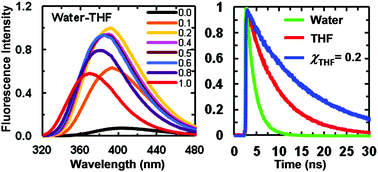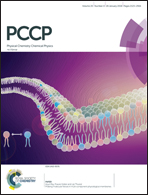7-Cyanoindole fluorescence as a local hydration reporter: application to probe the microheterogeneity of nine water-organic binary mixtures†
Abstract
Considerable efforts have been devoted to the development of spectroscopic probes that are sensitive to water and can be used to monitor, for example, biological and chemical processes involving dehydration or hydration. Continuing this line of research, herein we show that 7-cyanoindole can serve as a sensitive fluorescence probe of hydration as its fluorescence properties, including intensity, peak wavelength and lifetime, depend on the amount of water in nine water–organic solvent mixtures. Our results indicate that 7-cyanoindole is not only able to reveal the underlying microheterogeneity of these binary solvent systems, but also offers distinct advantages. These include: (1) its fluorescence intensity increases more than ten times upon going from a hydrated to a dehydrated environment; (2) its peak wavelength shifts as much as 35 nm upon dehydration; (3) its single-exponential fluorescence decay lifetime increases from 2.0 ns in water to 8–16 ns in water–organic binary mixtures, making it viable to distinguish between differently hydrated environments via fluorescence lifetime measurements; and (4) its absorption spectrum is significantly red-shifted from that of indole, making selective excitation of its fluorescence possible in the presence of naturally occurring amino-acid fluorophores. Moreover, we find that for seven binary mixtures the fluorescence lifetimes of 7-cyanoindole measured at solvent compositions where maximum microheterogeneity occurs correlate linearly with the peak wavenumbers of its fluorescence spectra obtained in the respective pure organic solvents. This suggests that the microheterogeneities of these binary mixtures bear certain similarity, a phenomenon that warrants further investigation.



 Please wait while we load your content...
Please wait while we load your content...